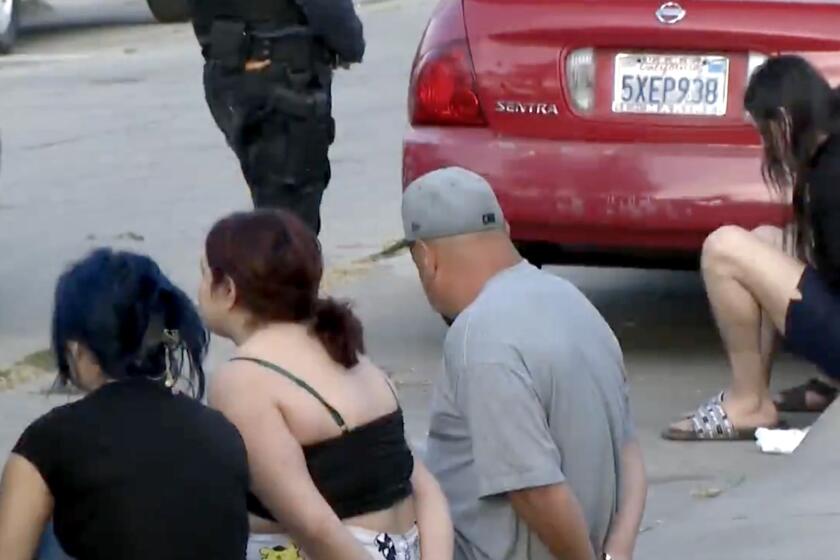Editorial: The voter turnout conundrum in L.A.
It’s one of the worst ideas we’ve heard in a long time: Last week, the Los Angeles Ethics Commission floated a plan to offer cash prizes as an incentive to get Angelenos to vote in local elections. Sheer desperation, as far as we can tell, led the commission to propose an election day lottery, with a jackpot of $1,000 or more that might persuade more registered voters to go to the polls.
Would it work? Probably. But it’s still a bad idea.
The folks pushing the lottery concept are well-intentioned and obviously disheartened by Los Angeles’ record of terrible voter turnout. Just 23% of registered voters bothered to cast a ballot in last year’s mayoral election. Last week, turnout was an abysmal 9.5% for a Los Angeles Unified School Board special election. But dangling a cash prize over the polls is a cynical and superficial pseudo-solution that fails to address the deeper reasons why people don’t vote. If the Ethics Commission and the City Council want to increase engagement and participation on election day — and they should — they would do better to focus on specific changes that make it easier to cast a ballot, while also getting to work on larger, longer-term reforms that could help counter the pervasive civic malaise that prevents so many Angelenos from feeling engaged in the democratic process.
There are plenty of proposals out there to boost turnout. One is to change L.A.’s election dates. Voters currently cast ballots for city offices in March primaries and May general elections in odd-numbered years. The Municipal Elections Reform Commission, appointed after the embarassingly low-turnout 2013 election, recommended moving local elections to June and November of even-numbered years, to coincide with gubernatorial and presidential elections that draw far greater participation. Of course, there are potential drawbacks to synchronizing local elections with state and federal ones — including cluttered ballots and increased campaign “noise” — but the advantages might make it worthwhile. Mayor Eric Garcetti and the City Council should not rule it out.
Another proposal is to let people cast their ballots wherever they want. Eliminate the precinct voting model and put voting centers in highly visible, well-traveled locations, such as malls or schools. This would make voting more convenient.
Here’s another: Hold fewer special elections. They can cost $1 million each or more, yet they draw few participants and contribute to voter fatigue — the feeling of a never-ending election cycle. Instead, appoint people to fill vacancies until the next regularly scheduled election.
These ideas deserve serious consideration, and over the next few weeks, The Times will return to some of them in more detail. They would no doubt increase the percentage of registered voters who turn out for local elections. That in itself is important, because an election in which 40% turn out has more legitimacy and more buy-in than an election with 20% participation. A democracy in which local officials are selected by just 1 in 5 or 1 in 8 or 1 in 10 voters is obviously not working.
But ultimately, the proposals above are procedural changes that treat the symptoms rather than the underlying motivational causes of low turnout. People don’t vote for a number of reasons. They don’t think their single vote matters, so why bother? They don’t see meaningful differences between the candidates, especially in a city like Los Angeles, where nominally nonpartisan candidates often share the same positions. They don’t understand the complicated issues at stake or they have more immediate economic or family concerns and voting is not a priority.
L.A. is certainly not the only city that suffers from low participation in local elections. But here, as elsewhere, reviving civic engagement may require big changes in how residents are educated and representatives are chosen. Here are some ways to start:
Teach civics in schools. Most California students take one American government class that is more focused on the federal system and on memorization of facts, rather than on what it means to be a citizen. That may be one reason a recent state survey found that less than half of high school seniors believed they have a responsibility to be involved in state and local issues. The state should include civics as part of its history and social science standards, and school districts should ensure that students learn about the duties of citizenship, such as voting, serving on a jury and knowing who their elected representatives are, as well as the opportunities that come with civic engagement, such as the ability to improve one’s community and correct injustice.
Encourage a broader range of candidates and more competitive races. People vote when they have strong feelings about the candidates in a competitive race. Turnout was 45% in the 1993 mayor’s race when Richard Riordan won against Michael Woo, the first Chinese American candidate to run for the office. Voter participation was also high (compared to today) at 37% in 2001 and 34% in 2005 when Antonio Villaraigosa sought to become L.A.’s first Latino mayor in modern history. Too often there are not competitive races for open seats. For the first time in decades, there were open seats on the County Board of Supervisors, yet Hilda Solis coasted to victory with virtually no competition after the political establishment pre-selected her for the job. And too often the quality of candidates is shamefully low, in part because the incumbent-friendly campaign finance system and the onerous requirements of fundraising in the city — and state and nation — keep good challengers from running.
Change the culture of campaigning. Elected officials need to acknowledge that their own behavior and political campaign tactics may be turning off potential voters. The proliferation of unfair or unsubstantiated attack ads. The generic blather of debates. The cookie-cutter mailers. Candidates for local elections usually have a real passion for public service, but they have to find a way to cut through the noise to connect with potential voters. This is no easy task in a city as large as Los Angeles, but more creativity and effort could help counter the cynicism and disinterest that stifles turnout.
Follow the Opinion section on Twitter @latimesopinion
More to Read
A cure for the common opinion
Get thought-provoking perspectives with our weekly newsletter.
You may occasionally receive promotional content from the Los Angeles Times.










